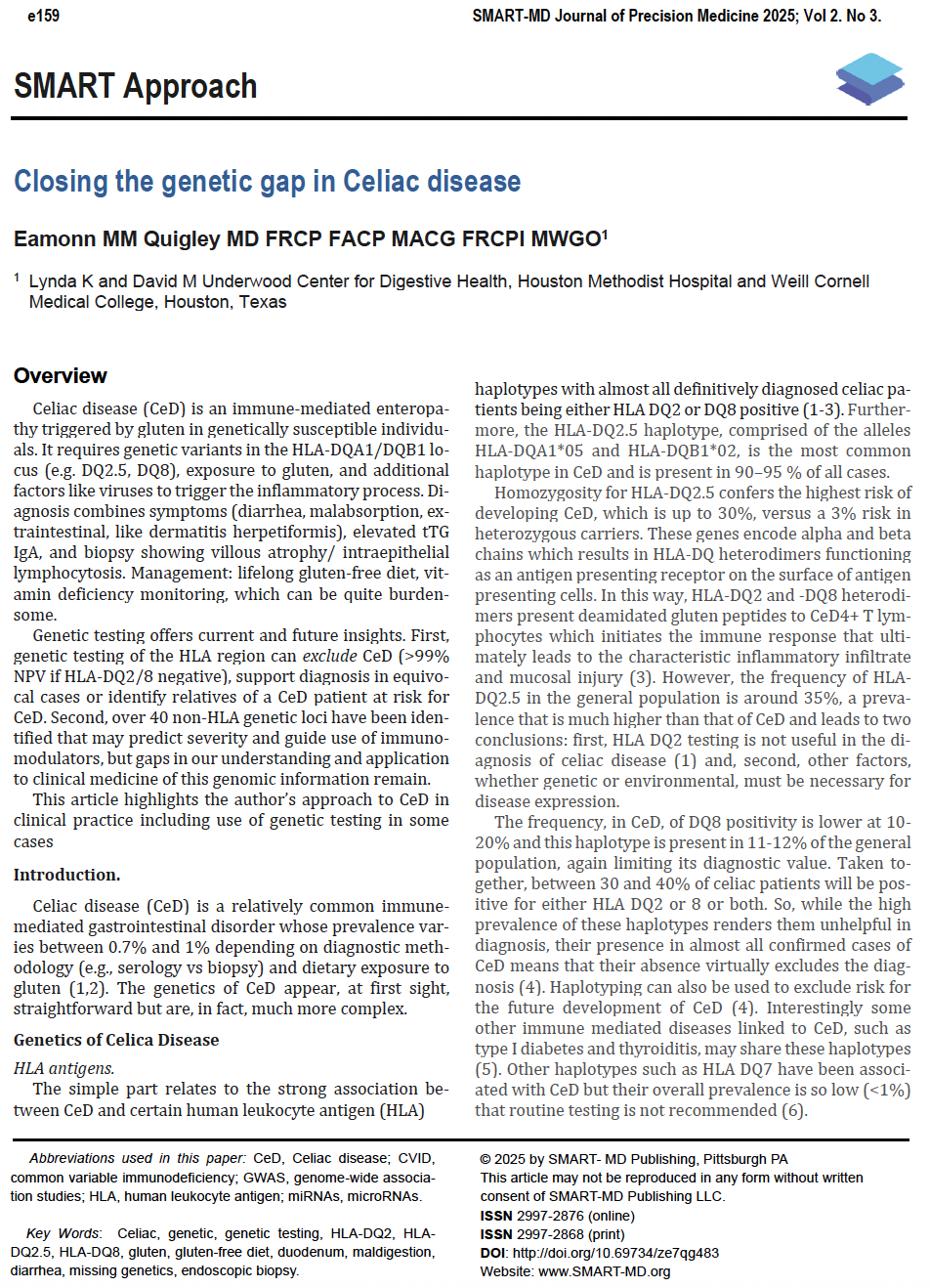SMART-Approach Closing the genetic gap in Celiac disease
Genetic Gap in Celiac Disease - Expert Approach
DOI:
https://doi.org/10.69734/ze7qg483Keywords:
celiac, gluten, duodenum, maldigestion, HLA-DQ2, HLA-DQ8, genetic, genetic modifiersAbstract
Celiac disease (CeD) is an immune-mediated enteropathy triggered by gluten in genetically susceptible individuals. It requires genetic variants in the HLA-DQA1/DQB1 locus (e.g. DQ2.5, DQ8), exposure to gluten, and additional factors like viruses to trigger the inflammatory process. Diagnosis combines symptoms (diarrhea, malabsorption, extraintestinal, like dermatitis herpetiformis), elevated tTG IgA, and biopsy showing villous atrophy/ intraepithelial lymphocytosis. Management: lifelong gluten-free diet, vitamin deficiency monitoring, which can be quite burdensome.
Genetic testing offers current and future insights. First, genetic testing of the HLA region can exclude CeD (>99% NPV if HLA-DQ2/8 negative), support diagnosis in equivocal cases or identify relatives of a CeD patient at risk for CeD. Second, over 40 non-HLA genetic loci have been identified that may predict severity and guide use of immunomodulators, but gaps in our understanding and application to clinical medicine of this genomic information remain.
This article highlights the author’s approach to CeD in clinical practice including use of genetic testing in some cases
References
Rubio-Tapia A., Hill I.D., Semrad C., Kelly C.P., Greer K.B., Limketkai B.N., Lebwohl B. American College of Gastroen-terology guidelines update: Diagnosis and management of celiac disease. Am J Gastroenterol 2023;118:59–76. PMID: 36602836
Gatti S, Rubio-Tapia A, Makharia G, Catassi C. Patient and community global burden in a world with more celiac dis-ease. Gastroenterology 2024;167:23-33. PMID: 38309629
Abadie V, Han AS, Jabri B, Sollid LM. New insights on genes, gluten and immunopathogenesis of celiac disease. Gastroenterology 2024;167:4-22. PMID: 38670280
Schirru E, Rossino R, Jores RD, Corpino M, Muntoni S, Cucca F, Congia M. Clinical settings in which human leukocyte antigen typing is still useful in the diagnosis of celiac dis-ease. World J Gastroenterol 2025;31104397. PMID: 40248378
Schirru E, Rossino R, Diana D, Jores RD, Baldera D, Mun-toni S, Spiga C, Ripoli C, Ricciardi MR, Cucca F, Congia M. HLA Genotyping in Children With Celiac Disease Allows to Establish the Risk of Developing Type 1 Diabetes. Clin Transl Gastroenterol. 2024;15:e00710. PMID: 38713138
Rouvroye MD, Roos A, Bergkamp F, Haagen IA, van der Pol P, Neefjes-Borst EA, Bouma G, Bontkes HJ. The fre-quency of HLA-DQ7 in patients at risk of coeliac disease: A haplotype to be reckoned with for screening? Hum Im-munol. 2024;85:111158. PMID: 39423728
Karimzadhagh S, Abbaspour E, Shahriar G, et al. Global prevalence and clinical manifestations of celiac disease among first-degree relatives: A systematic review and meta-analysis. Am J Gastroenterol 2025;120:1488. PMID: 39584667
Kuja-Halkola R, Lebwohl B, Halfvarson J, Wijmenga C, Mag-nusson PKE, Ludvigsson JF. Heritability of non-HLA ge-netics in coeliac disease: a population-based study in 107,000 twins. Gut 2016;65:1983-8. PMID: 27207974
Liu E, Lee H-S, Aronsson CA, et al. Risk of pediatric celiac disease according to HLA haplotype and country. N Engl J Med 2014;371:42-9. PMID: 24988556
Trynka G., Hunt K.A., Bockett N.A., Romanos J., Mistry V., Szperl A., Bakker S.F., Bardella M.T., Bhaw-Rosun L., Cas-tillejo G., et al. Dense genotyping identifies and localizes multiple common and rare variant association signals in celiac disease. Nat. Genet. 2011;43:1193–1201. PMID: 22057235
Ricaño-Ponce I., Gutierrez-Achury J., Costa A.F., Deelen P., Kurilshikov A., Zorro M.M., Platteel M., van der Graaf A., Sugai E., Moreno M.L., et al. Immunochip meta-analysis in European and Argentinian populations identifies two nov-el genetic loci associated with celiac disease. Eur. J. Hum. Genet. 2020;28:313–323. MID: 31591516
Alam MS, Thomas L, Brumpton B, et al. Population screen-ing of adults identifies novel genetic variants associated with celiac disease. Sci Rep 2025;15:109764. PMID: 40473712
Rigo FF, Oliveira ECS, Quaglio AEV, Moutinho BD, Di Stasi LC, Sassaki LY. Expression of MicroRNAs in Adults with Ce-liac Disease: A Narrative Review. Int J Mol Sci. 2024;25:9412. PMID: 39273359

Downloads
Published
Issue
Section
License
Copyright (c) 2025 SMART-MD Journal of Precision Medicine

This work is licensed under a Creative Commons Attribution 4.0 International License.

